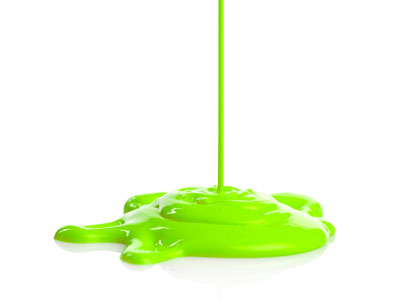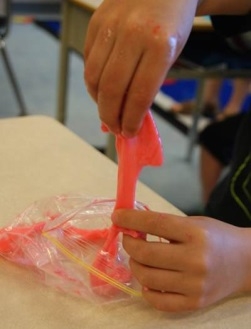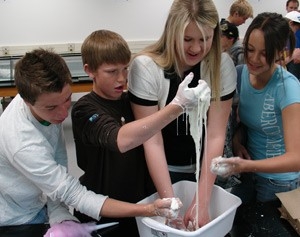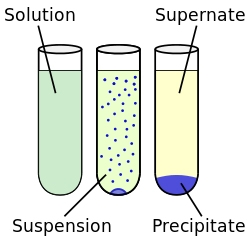Is it a liquid or a solid?

Ambiguous green substance (natalie-claude - iStock)
Make some goop that has the properties of a liquid and a solid.
What You Need
- Shallow dish (e.g. cereal bowl)
- Stir stick
- Cornstarch
- Measuring spoon (tsp)
- Food colouring (optional)
- Water
What To Do
- Place 5 teaspoons of cornstarch in the dish.children playing with goop
- Add a few drops of food colouring to the cornstarch (this is optional).
- Add 2 teaspoons of water to the mixture and stir thoroughly. If the mixture is too stiff, just add a few drops of water at a time. You should not need more than 3 teaspoons of water. You should be able to stir the final product but it should not be too “liquidy”.
- Scoop a teaspoon full of the goop into your hand. Observe what happens when you squeeze it.
Discovery
Cornstarch goop is a very peculiar substance as it has the properties of both a solid and a liquid. It is a suspension, meaning that solid particles of cornstarch are suspended in water. When the mixture is squeezed or pressed the molecules line up in a regular pattern, as they do in a normal solid. This makes the goop feel and act as a solid. When the pressure is released the molecules form the random arrangement of a liquid and the goop suddenly flows.
All fluids have a measurable viscosity. Viscosity is the thickness or resistance to flow of a liquid. Water, for instance, has a low viscosity because it pours easily. In comparison, honey is a very thick liquid and can take a long time to pour, so it has a high viscosity. Normal fluids, called Newtonian fluids, change viscosity only when the temperature changes. That is, when honey is warmed up it is easier to pour, but when it is cooled down it is much harder to pour.
Cornstarch goop is an example of a non-Newtonian fluid. The viscosity of the goop can be changed by temperature and also by pressure. Quicksand is also non-Newtonian fluid. That's why the best way to get out of quicksand is to move slowly. Too fast and the quicksand will stiffen like cornstarch goop.
- Hold the mixture in your hands, squeeze it, let it go and find out what happens to the mixture in each case.
- Try putting the goop mixture in a fridge or freezer for 30 – 60 minutes. How does the cold temperature affect the goop?
For more information on this topic check out these Let's Talk Science resources:
- What happens when we mix liquids? (Hands-on Activities) - Mix it up! What happens when you mix different liquids? Learn about the properties of liquids as you get mixing.
- Properties of Liquids and Solids (Lessons) - Students develop and apply observing, comparing & contrasting and predicting skills as they explore the properties of common liquids and solids.
- States of Matter (Backgrounders) - Learn about the states of matter, as well more about one state in particular - gas!
What’s happening?
Cornstarch goop is a very peculiar substance as it has the properties of both a solid and a liquid. It is a suspension, meaning that solid particles of cornstarch are suspended in water. When the mixture is squeezed or pressed the molecules line up in a regular pattern, as they do in a normal solid. This makes the goop feel and act as a solid. When the pressure is released the molecules form the random arrangement of a liquid and the goop suddenly flows.
Why does it matter?
All fluids have a measurable viscosity. Viscosity is the thickness or resistance to flow of a liquid. Water, for instance, has a low viscosity because it pours easily. In comparison, honey is a very thick liquid and can take a long time to pour, so it has a high viscosity. Normal fluids, called Newtonian fluids, change viscosity only when the temperature changes. That is, when honey is warmed up it is easier to pour, but when it is cooled down it is much harder to pour.
Cornstarch goop is an example of a non-Newtonian fluid. The viscosity of the goop can be changed by temperature and also by pressure. Quicksand is also non-Newtonian fluid. That's why the best way to get out of quicksand is to move slowly. Too fast and the quicksand will stiffen like cornstarch goop.
Investigate further
- Hold the mixture in your hands, squeeze it, let it go and find out what happens to the mixture in each case.
- Try putting the goop mixture in a fridge or freezer for 30 – 60 minutes. How does the cold temperature affect the goop?
For more information on this topic check out these Let's Talk Science resources:
- What happens when we mix liquids? (Hands-on Activities) - Mix it up! What happens when you mix different liquids? Learn about the properties of liquids as you get mixing.
- Properties of Liquids and Solids (Lessons) - Students develop and apply observing, comparing & contrasting and predicting skills as they explore the properties of common liquids and solids.
- States of Matter (Backgrounders) - Learn about the states of matter, as well more about one state in particular - gas!


